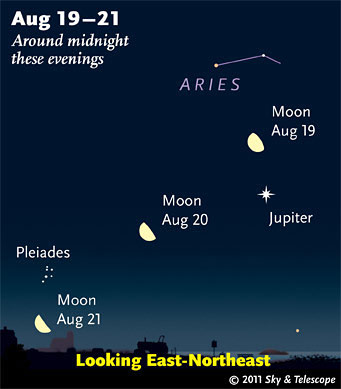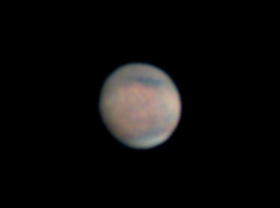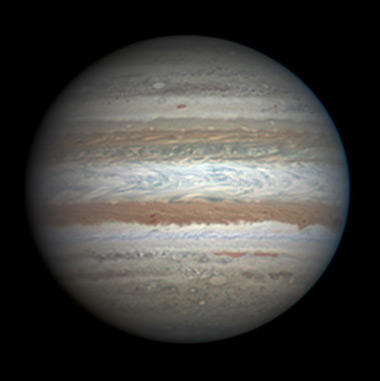Friday, August 12
Saturday, August 13
Sunday, August 14

John Boudreau
Monday, August 15
Tuesday, August 16
Wednesday, August 17
Thursday, August 18

Late at night, the waning Moon passes bright Jupiter.
Sky & Telescope diagram
Friday, August 19
Saturday, August 20
Ceres, a future destination for Dawn (it'll get there in February 2015), lurks two constellations farther to the east in Cetus. It's currently magnitude 8.0.
Want to become a better amateur astronomer? Learn your way around the constellations. They're the key to locating everything fainter and deeper to hunt with binoculars or a telescope.
For an easy-to-use constellation guide covering the whole evening sky, use the big monthly map in the center of each issue of Sky & Telescope, the essential magazine of astronomy. Or download our free Getting Started in Astronomy booklet (which only has bimonthly maps).
Sky Atlas 2000.0 (the color Deluxe Edition is shown here) plots 81,312 stars to magnitude 8.5. That includes most of the stars that you can see in a good finderscope, and typically one or two stars that will fall within a 50× telescope's field of view wherever you point. About 2,700 deep-sky objects to hunt are plotted among the stars.
Alan MacRobert
Once you get a telescope, to put it to good use you must have a detailed, large-scale sky atlas (set of charts). The standards are the Pocket Sky Atlas, which shows stars to magnitude 7.6; the larger Sky Atlas 2000.0 (stars to magnitude 8.5); and the even larger and deeper Uranometria 2000.0 (stars to magnitude 9.75). And read how to use sky charts effectively.
You'll also want a good deep-sky guidebook, such as Sky Atlas 2000.0 Companion by Strong and Sinnott, or the more detailed and descriptive Night Sky Observer's Guide by Kepple and Sanner, or the classic if dated Burnham's Celestial Handbook.
Can a computerized telescope take their place? I don't think so — not for beginners, anyway, and especially not on mounts that are less than top-quality mechanically. As Terence Dickinson and Alan Dyer say in their Backyard Astronomer's Guide, "A full appreciation of the universe cannot come without developing the skills to find things in the sky and understanding how the sky works. This knowledge comes only by spending time under the stars with star maps in hand."
This Week's Planet Roundup

If you have any doubt that stacked-video imaging can do black magic on the planets compared to what you see by eye in the same telescope, look at this. Mars was a mere 4.5 arcseconds wide on August 13th when John Boudreau of Saugus, Massachusetts, took this image with an 11-inch scope. Visually, Mars at that size is a tiny, featureless fuzzblob. Go look before dawn if you don't believe me.
Click for an animation of two images showing 7 minutes of the planet's rotation. This makes it easy to see what features are real rather than noise. Hint: Most of them are.
Boudreau used a C-11 telescope at f/38 with a PGR Flea 3 camera and Astrodon RGB color filters. He rated the seeing as only 6 or 7 on a scale of 10. And the planet was only 32° high. (South is up.)
John Boudreau
Mercury and Venus are hidden in the glare of the Sun.
Mars (magnitude +1.4, in the feet of Gemini) rises around 2 or 3 a.m. daylight-saving time. By dawn it's in good view in the east. It's the "star" far lower right of Capella, far lower left of Aldebaran, and less far left of similarly-colored Betelgeuse. In a telescope, Mars is still just a very tiny blob 4.5 arcseconds in diameter.
Jupiter (magnitude –2.5, in southern Aries) rises in the east-northeast around 11 or midnight daylight saving time. Look above it for the little star pattern of Aries and (once Jupiter is well up) closer below it for the head of Cetus, rather dim. By early dawn Jupiter shines very high in the southeast to south, making this the best time to examine it with a telescope.
>

Do you even recognize this planet? "Seeing was excellent this morning," writes Christopher Go from the Philippines on August 16th. "These are probably my best images so far this season."
This is the side of Jupiter away from the Great Red Spot. South is up.
"Note the two [tiny] dark ovals on the North Equatorial Belt," just below center and a little left of the central meridian, Go writes. "They are on the verge of merging! The [white] Equatorial Zone looks very complex. The [broad, dark] South Equatorial Belt [above center] is very complex. Note the tiny white ovals lining up on the southern edge of the SEB. The South Tropical Zone [light, higher above] is reddish." Go made this stacked-video image using a C-14 scope.
Saturn (magnitude +0.9, in Virgo) is sinking ever lower in the west-southwest at dusk. Look far below high, bright Arcturus. Left of Saturn by 11° is Spica. Right or lower right of Saturn by 3° is fainter Gamma Virginis (binoculars will help).
Uranus (magnitude 5.8, in western Pisces) and Neptune (magnitude 7.8, in western Aquarius) are well up in the east or southeast before midnight. Here's our printable finder chart for both.
Pluto (magnitude 14.0, in northern Sagittarius) is highest in the south right after dark. A big finder chart for it is in the July Sky & Telescope, page 64.
All descriptions that relate to your horizon — including the words up, down, right, and left — are written for the world's mid-northern latitudes. Descriptions that also depend on longitude (mainly Moon positions) are for North America. Eastern Daylight Time (EDT) equals Universal Time (also known as UT, UTC, or GMT) minus 4 hours.
To be sure to get the current Sky at a Glance, bookmark this URL:
http://SkyandTelescope.com/observing/ataglance?1=1
If pictures fail to load, refresh the page. If they still fail to load, change the 1 at the end of the URL to any other character and try again.
 0
0
Comments
You must be logged in to post a comment.